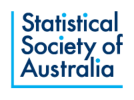Menu
Log in
Statistical Society of Australia (SSA) |
© 2019 Statistical Society of Australia (SSA). All Rights Reserved. | member login | Website by Converge Design |
Powered by Wild Apricot Membership Software
Statistical Society of Australia (SSA) |
© 2019 Statistical Society of Australia (SSA). All Rights Reserved. | member login | Website by Converge Design |
